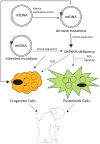Mechanisms linking mtDNA damage and aging
- PMID: 25979659
- PMCID: PMC4508218
- DOI: 10.1016/j.freeradbiomed.2015.05.005
Mechanisms linking mtDNA damage and aging
Abstract
In the past century, considerable efforts were made to understand the role of mitochondrial DNA (mtDNA) mutations and of oxidative stress in aging. The classic mitochondrial free radical theory of aging, in which mtDNA mutations cause genotoxic oxidative stress, which in turn creates more mutations, has been a central hypothesis in the field for decades. In the past few years, however, new elements have discredited this original theory. The major sources of mitochondrial DNA mutations seem to be replication errors and failure of the repair mechanisms, and the accumulation of these mutations as observed in aged organisms seems to occur by clonal expansion and not to be caused by a reactive oxygen species-dependent vicious cycle. New hypotheses of how age-associated mitochondrial dysfunction may lead to aging are based on the role of reactive oxygen species as signaling molecules and on their role in mediating stress responses to age-dependent damage. Here, we review the changes that mtDNA undergoes during aging and the past and most recent hypotheses linking these changes to the tissue failure observed in aging.
Keywords: Aging; Free radicals; Mitochondria; MtDNA; Mutation.
Copyright © 2015 Elsevier Inc. All rights reserved.
Conflict of interest statement
The authors declare no competing financial interests.
Figures

Similar articles
-
[Mitochondria, oxidative stress and aging].Orv Hetil. 2014 Mar 23;155(12):447-52. doi: 10.1556/OH.2014.29852. Orv Hetil. 2014. PMID: 24631932 Review. Hungarian.
-
[Oxidative damage of mitochondrial DNA: the result or consequence of enhanced generation of reactive oxygen species].Postepy Biochem. 2010;56(2):139-46. Postepy Biochem. 2010. PMID: 20873108 Review. Polish.
-
Mitochondrial theory of aging matures--roles of mtDNA mutation and oxidative stress in human aging.Zhonghua Yi Xue Za Zhi (Taipei). 2001 May;64(5):259-70. Zhonghua Yi Xue Za Zhi (Taipei). 2001. PMID: 11499335 Review.
-
Mitochondrial DNA damage and the aging process: facts and imaginations.Free Radic Res. 2006 Dec;40(12):1284-94. doi: 10.1080/10715760600913168. Free Radic Res. 2006. PMID: 17090418 Review.
-
Oxidative stress response elicited by mitochondrial dysfunction: implication in the pathophysiology of aging.Exp Biol Med (Maywood). 2013 May;238(5):450-60. doi: 10.1177/1535370213493069. Exp Biol Med (Maywood). 2013. PMID: 23856898 Review.
Cited by
-
Reproduction Does Not Adversely Affect Liver Mitochondrial Respiratory Function but Results in Lipid Peroxidation and Increased Antioxidants in House Mice.PLoS One. 2016 Aug 18;11(8):e0160883. doi: 10.1371/journal.pone.0160883. eCollection 2016. PLoS One. 2016. PMID: 27537547 Free PMC article.
-
Nutrients, Mitochondrial Function, and Perinatal Health.Nutrients. 2020 Jul 21;12(7):2166. doi: 10.3390/nu12072166. Nutrients. 2020. PMID: 32708345 Free PMC article. Review.
-
Mitochondrial DNA Mutagenesis: Feature of and Biomarker for Environmental Exposures and Aging.Curr Environ Health Rep. 2021 Dec;8(4):294-308. doi: 10.1007/s40572-021-00329-1. Epub 2021 Nov 11. Curr Environ Health Rep. 2021. PMID: 34761353 Free PMC article. Review.
-
Downregulating Mitochondrial DNA Polymerase γ in the Muscle Stimulated Autophagy, Apoptosis, and Muscle Aging-Related Phenotypes in Drosophila Adults.Biomolecules. 2022 Aug 11;12(8):1105. doi: 10.3390/biom12081105. Biomolecules. 2022. PMID: 36008999 Free PMC article.
-
Weaning disrupts intestinal antioxidant status, impairs intestinal barrier and mitochondrial function, and triggers mitophagy in piglets.J Anim Sci. 2018 Apr 3;96(3):1073-1083. doi: 10.1093/jas/skx062. J Anim Sci. 2018. PMID: 29617867 Free PMC article.
References
-
- Long YC, et al. The biochemistry and cell biology of aging: metabolic regulation through mitochondrial signaling. Am J Physiol Endocrinol Metab. 2014;306(6):E581–91. - PubMed
-
- Harman D. Aging: a theory based on free radical and radiation chemistry. J Gerontol. 1956;11(3):298–300. - PubMed
-
- Muller FL, et al. Trends in oxidative aging theories. Free Radic Biol Med. 2007;43(4):477–503. - PubMed
Publication types
MeSH terms
Substances
Grants and funding
LinkOut - more resources
Full Text Sources
Other Literature Sources
Miscellaneous

